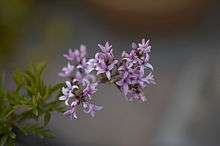Syringa × laciniata
Syringa × laciniata, the cut-leaf lilac or cutleaf lilac, is a hybrid lilac of unknown, though old origin. It is thought to be a hybrid between Syringa vulgaris from southeastern Europe and Syringa protolaciniata from western China.[1] Although often cited as being from China,[2] it more likely arose somewhere in southwestern Asia, where it was first scientifically described from cultivated plants in the 17th century, possibly Iran or Afghanistan,[3] or Pakistan, where it has been cultivated since ancient times.[4]
| Syringa × laciniata | |
|---|---|
 | |
| Scientific classification | |
| Kingdom: | |
| (unranked): | |
| (unranked): | |
| (unranked): | |
| Order: | |
| Family: | |
| Genus: | |
| Species: | S. × laciniata |
| Binomial name | |
| Syringa × laciniata | |
It is a deciduous shrub growing to 2 m tall. The leaves are 2–4 cm long, variably entire or cut deeply into three to nine lobes or leaflets. The flowers are pale lilac, produced in loose panicles up to 7 cm long in mid spring. It is hardy to USDA plant hardiness zone 5.[2][4]
See also
References
- "Syringa ×laciniata". Germplasm Resources Information Network (GRIN). Agricultural Research Service (ARS), United States Department of Agriculture (USDA). Retrieved 23 January 2018.
- Huxley, A., ed. (1992). New RHS Dictionary of Gardening. Macmillan ISBN 0-333-47494-5.
- Bean, W. J. (1980). Trees and Shrubs Hardy in the British Isles 8th ed., vol. 4. John Murray ISBN 0-7195-2428-8.
- Flora of Pakistan: Syringa laciniata
| Wikimedia Commons has media related to Syringa × laciniata. |